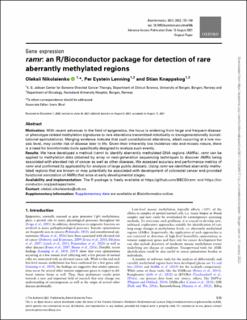| dc.contributor.author | Nikolaienko, Oleksii | |
| dc.contributor.author | Lønning, Per Eystein | |
| dc.contributor.author | Knappskog, Stian | |
| dc.date.accessioned | 2023-01-31T15:23:37Z | |
| dc.date.available | 2023-01-31T15:23:37Z | |
| dc.date.created | 2022-12-16T11:24:26Z | |
| dc.date.issued | 2022 | |
| dc.identifier.issn | 1367-4803 | |
| dc.identifier.uri | https://hdl.handle.net/11250/3047491 | |
| dc.description.abstract | Motivation: With recent advances in the field of epigenetics, the focus is widening from large and frequent disease- or phenotype-related methylation signatures to rare alterations transmitted mitotically or transgenerationally (constitutional epimutations). Merging evidence indicate that such constitutional alterations, albeit occurring at a low mosaic level, may confer risk of disease later in life. Given their inherently low incidence rate and mosaic nature, there is a need for bioinformatic tools specifically designed to analyze such events.
Results: We have developed a method (ramr) to identify aberrantly methylated DNA regions (AMRs). ramr can be applied to methylation data obtained by array or next-generation sequencing techniques to discover AMRs being associated with elevated risk of cancer as well as other diseases. We assessed accuracy and performance metrics of ramr and confirmed its applicability for analysis of large public datasets. Using ramr we identified aberrantly methylated regions that are known or may potentially be associated with development of colorectal cancer and provided functional annotation of AMRs that arise at early developmental stages. | en_US |
| dc.language.iso | eng | en_US |
| dc.publisher | Oxford University Press | en_US |
| dc.rights | Navngivelse-Ikkekommersiell 4.0 Internasjonal | * |
| dc.rights.uri | http://creativecommons.org/licenses/by-nc/4.0/deed.no | * |
| dc.title | ramr: an R/Bioconductor package for detection of rare aberrantly methylated regions | en_US |
| dc.type | Journal article | en_US |
| dc.type | Peer reviewed | en_US |
| dc.description.version | publishedVersion | en_US |
| dc.rights.holder | Copyright 2021 the authors | en_US |
| cristin.ispublished | true | |
| cristin.fulltext | original | |
| cristin.qualitycode | 2 | |
| dc.identifier.doi | 10.1093/bioinformatics/btab586 | |
| dc.identifier.cristin | 2094278 | |
| dc.source.journal | Bioinformatics | en_US |
| dc.source.pagenumber | 133-140 | en_US |
| dc.identifier.citation | Bioinformatics. 2022, 38 (1), 133-140. | en_US |
| dc.source.volume | 38 | en_US |
| dc.source.issue | 1 | en_US |

